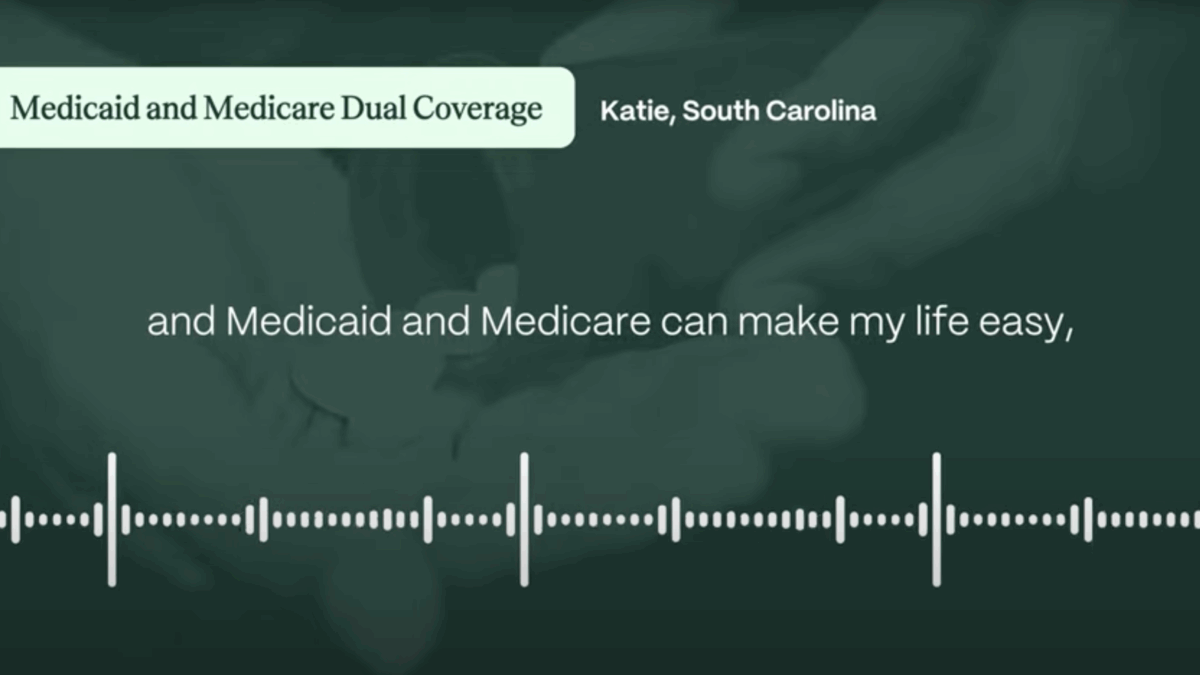When Medicaid and Medicare work together, they can be a lifeline: Katie’s Story
Meet Katie
When Katie was diagnosed with a leaky heart valve, she was told that to manage her condition effectively, she would need to be on Eliquis, a stroke-prevention medication, for the rest of her life. What seemed like a solution quickly turned into a problem when she learned that her Medicare coverage wouldn’t cover the cost of the medication, and paying out-of-pocket would cost her about $2,100 for a three-month supply. For someone living on a fixed income, this was money Katie didn’t have. Unable to afford these high out-of-pocket expenses, Katie reached out to her doctor for help.
Her doctor worked with her to find a solution—Medicaid. With her doctor’s help, Katie enrolled in Medicaid. Now thanks to both her Medicare and Medicaid coverage, Katie is able to pick up her prescription every month without worrying about choosing between a life-saving medication and putting food on the table.
“When you get older, there’s not a lot of things you want. If you’re able to pay your bills, pay for your medicine, go to the doctor when you need to go, that means a lot.” Thanks to both Medicaid and Medicare, Katie is able to get the care she needs to be and stay healthy—and to her that means the world.
It’s About More Than Just Health Coverage
Katie faced a challenge that millions of older adults know all too well: affording the medications she needs to stay healthy. For her, Medicaid and Medicare provide more than health coverage—they’re a lifeline.
“[Medicaid and Medicare] mean a whole lot to me…and not only me,” Katie explains. “I hear a lot of people around my age say the same thing. They didn’t know how they would make it but without that.”
While Katie was lucky to have a doctor help her transition from one coverage, Medicare, to two types of coverage, Medicaid and Medicare, she represents the exception, not the rule. Not all doctors have the time or expertise to help their patients navigate the intricacies of health coverage and the enrollment processes for both Medicaid and Medicare.
Nearly 12 million people in the U.S. are “dually eligible,” meaning they depend on both Medicare and Medicaid for their health coverage and care. Most dually eligible people are older adults and people with disabilities who live on low, fixed incomes, manage multiple chronic conditions like diabetes and heart disease, and need assistance with daily living activities like getting dressed, bathing, or eating.
For many dually eligible people like Katie the stakes are high when navigating coverage and selecting a health plan, nobody’s health and wellbeing should be left up to luck. Like Katie, many dually eligible individuals may not even know they qualify for both Medicaid and Medicare, or if they do know, there is often not a support system with knowledge about both programs to provide neutral and clear guidance. Too often this results in people being left to navigate a sea of websites and disjointed systems that often results in people ending up on health care plans that don’t fully meet their needs. Dually eligible individuals shouldn’t have to roll the dice on their health—dependent on the off chance that they encounter someone who will go above and beyond to help get them on the right plan.
Investments to Improve Lives
With the right policies in place, dually eligible people can thrive in their communities, age in place, and get their complex health needs met.
For people like Katie, this starts with making sure they have access to the information and supports they need, when they need it, to navigate selecting coverage that meets their needs – regardless of where they live. This can be done through robust outreach towards underserved dually eligible individuals and their caregivers to provide them with reliable and accessible information. We need additional resources to make sure dually eligible people are supported to understand the different plans, benefits available, and how to effectively access them to get the care they need. We can drive forward these changes by:
- Providing additional investments to existing trusted organizations and community-based organizations that are already meeting dually eligible people where they are at—helping dually eligible people access and navigate local resources.
- Bolstering supports that are already working to provide communities with neutral and accessible enrollment information unaffiliated with any particular health plan, such as Medicare State Health Insurance Assistance Programs and Medicaid Navigators.
While many vital supports already exist – all too often they don’t have the capacity or resources to fully support people who are navigating the complexities of being covered by both Medicaid and Medicare. These investments are vital for ensuring that dually eligible people receive the person-centered care and improved health outcomes they need.
Without [Medicaid and Medicare], I can’t see where I could make it—to pay the light bill, car insurance, house insurance. It’s just too much for one person.
Millions of people rely on coverage from both Medicaid and Medicare for stability and peace of mind, both for themselves and their loved ones. Katie’s story highlights how life-changing and life-saving it can be when Medicare and Medicaid work together to meet people’s health needs. Through continued investments in education, outreach and support infrastructure, we can advance integrated care solutions that ensure every dually eligible person has access to the coverage and care they need, when they need it.
If you or someone you love relies on Medicaid and Medicare, your voice can make a difference.
Record a short video sharing how these changes could affect your life—whether you’re a caregiver, an older adult, someone with a disability, or just trying to stay healthy and housed.
Your story will show policymakers what’s really at stake and can help us demand better care for all.
